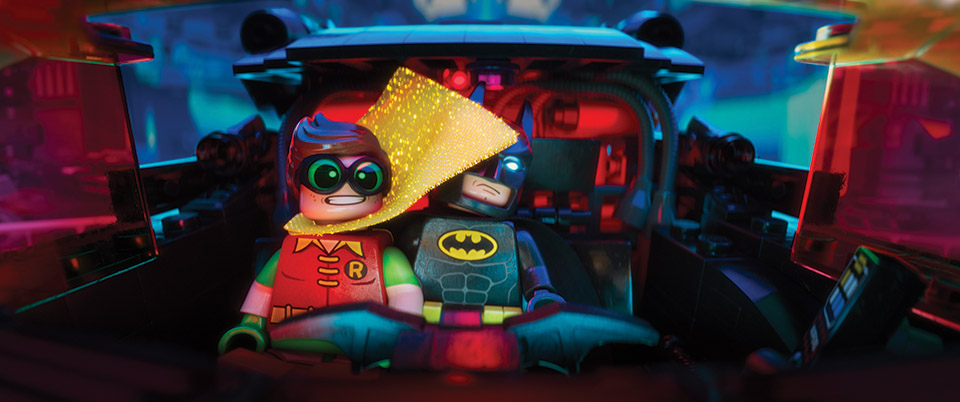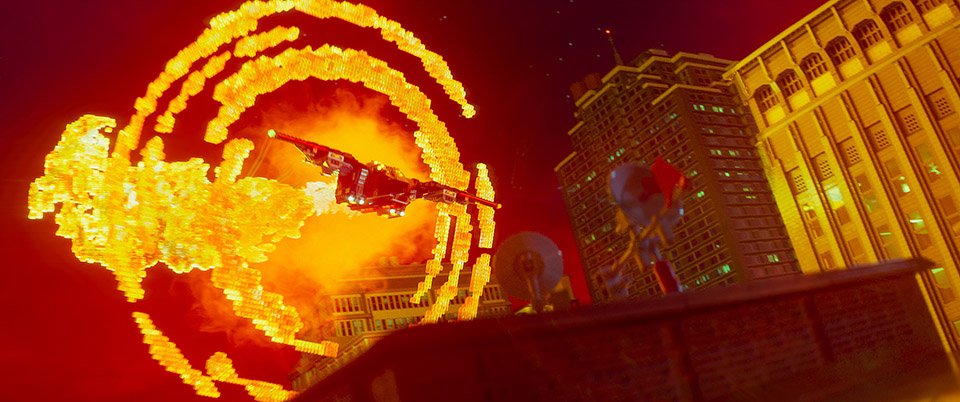
The makers of The LEGO Batman Movie bring to the big screen an action-packed and emotional take on the life of the Caped Crusader.
Batman’s been through a lot since he debuted in the pages of Detective Comics #27, but it’s taken until now — more than 75 years later — for anyone to have the kind of serious fun with the character seen in The LEGO Batman Movie, which arrives Feb. 10 in theaters from Warner Bros.
“He’s been interpreted a lot of different ways, from the comic books to the Adam West stuff, to Super Friends to Frank Miller and Tim Burton and Christopher Nolan and all of that,” says director Chris McKay. “And yet we were looking for a new way into this story, this character — a way that only we could do it. And one of the things we thought of, or had observed, from the history of Batman is that no one’s ever really gone at Batman’s central problem. Which is: Can Batman be happy? Can Batman get over the thing that happened to him when he was a little kid, the murder of his parents?”
That’s a big question, but it’s one that helped McKay when he pitched the idea to Warner Bros. and LEGO as something like “Jerry Maguire or About a Boy, but as directed by Michael Mann.” That didn’t even get to the sense of humor, which McKay says he wanted to be along the lines of the 1981 classic Airplane!, in that there were going to be a lot of jokes and there would be some for adults and some for kids. (It was important to McKay to make the movie family friendly, as the most recent Batman films — Nolan’s trilogy and last year’s Batman vs. Superman: Dawn of Justice — are geared toward an older audience, leaving younger viewers without the chance to see the Caped Crusader on the big screen.)
The movie features as the voice of Batman Will Arnett, reprising the role from 2014’s The LEGO Movie; with Michael Cera as Robin; Zach Galifianakis as Joker; Ralph Fiennes as Alfred; Rosario Dawson as Batgirl; and Billy Dee Williams as Two-Face.
Experienced Hand
McKay is no stranger to the LEGO franchise, having been brought on by The LEGO Movie directors Christopher Miller and Phil Lord as animation director and co-director, based on his experience directing such TV series as Robot Chicken, Titan Maximum and Moral Orel. “I wear a lot of hats and I expanded my role from co-director and animation director to co-editor and head of story, really, and I worked really closely with them and the studio and we had a great time working together,” says McKay. “It was a good trial run for directing on my own and I had relationships with all the people and they offered me the job to direct LEGO 2.”
But with The LEGO Movie sequel being an ambitious project with a lot of music and original songs, development stretched out and LEGO Batman ended up ready to go into production first. “They said: ‘We need a director to do this. Do you want to do Batman?’” McKay says. “I’m a huge comic-book fan and a huge Batman fan and so it just seemed like a natural fit for me to jump in and do it.”
Dealing with a movie that, on paper, has many masters, from DC Entertainment and Warner Bros. to The LEGO Group in Billund, Denmark, was not the easiest task but it also worked because everyone agreed on the basic idea, McKay says. “Because we were making move that is about Batman overcoming his fear of allowing people into his life, I think that was a common ground that everybody could get behind,” he says.
There was more pressure, however, than on The LEGO Movie, he says. “When we were making the first movie, we were left alone because nobody knew what it was going to be,” says McKay. “Because of the success of the last movie, there was a lot more pressure and a lot more people were more interested in participating in the process, so I think that probably made it more challenging.”
One of the biggest challenges on a LEGO movie is that the characters are all minifigs and the entire project has to look like a live-action shot of a real-life toy that was designed for anything but animation. But The LEGO Batman Movie was able to build on the experience won during the making of The LEGO Movie.
“On the first movie, we had to sort of educate people, both the studio as well as just sort of working with the animators on how to make a brick film in CG,” says McKay. “That was hard for people to overcome because … some of the things I was asking people to do was counterintuitive. I was asking them to use the computer less to interpret stuff and asking them to make more hands-on decisions, asking them to do stuff on twos instead of ones, to see more of the seams in what we were doing.”
After The LEGO Movie became a runaway critical and commercial success, many of the obstacles to the filmmakers’ approach fell by the wayside and the issues became specific to making The LEGO Batman Movie, McKay says. “I was asking them to make a much bigger movie than The LEGO Movie,” he says. “I wanted Gotham City to be bigger. For Bricksburg, we only built a couple of blocks; but I wanted Gotham City to be huge. I wanted, when you pull the camera back, I wanted you not to realize for a second you were in a LEGO movie.”
McKay also wanted to incorporate elements of Batman movies past, from the Oscar-winning art director Anton Furst’s work on the 1989 Burton movie to the bridges and rivers of Nolan’s shoot on location in Chicago, to the giant statues of Joel Shumacher’s much-maligned 1990s Batman films.
Playing Around
Animal Logic’s Rob Coleman was head of animation on The LEGO Movie and returned to the brick world as animation supervisor on The LEGO Batman Movie. “Stylistically, what we’re always after is to try to convince or fool or trick the audience into thinking they’re watching real LEGO pieces move around,” he says. “There seems to be a way human beings can project ourselves into these little toys, these little characters and, as animators, we’re trying to think about that when we’re animating the characters so the audience believes they are seeing the LEGOs come to life.”
One way the animators achieved that effect was by using what Coleman calls stepped keyed animation, with changes being done on twos, threes or even sixes, meaning the character is moved every two frames or three frames, etc. “We’re trying to make it look like you’ve got real LEGOs and you’re posing a character and then you’re advancing the film a couple of frames and then you’re moving it again,” he says.
For example, Coleman says in a dialog scene between Batman and Robin, the animators would move the body on fours or sixes and the mouth would be animated on twos. For action sequences, things often moved too fast, so everything was animated on ones to keep the movie from looking too jarring.
For some scenes, animators even added “brick blur,” a technique developed on The LEGO Movie to simulate motion blur. “Because Batman is made of black bricks and a yellow utility belt, if he’s moving really quickly, we will add additional black bricks and yellow bricks behind him to make it look like motion blur,” says Coleman. “We didn’t actually render with motion blur because that’s part of the nature of stop motion films, is you don’t get motion blur, so we added in this brick blur, which helps with the audience being able to follow fast action, whether it be a character or a vehicle.”
Of the animators, McKay says he asked them to push the action and the drama. “Asking the animators to specifically observe behavior more when we were developing some of the emotional scenes, and asking them to really create a lot of life behind the eyes of these characters, those were the challenges and the animators — I had a great group of animators and amazing animation leads who were super game and up for the task and fought really hard all the way.”
The schedule on the movie was especially tight, encompassing about two and a half years from starting with a treatment to the final movie. Animated entirely at Animal Logic in Sydney, Australia, Coleman says he started with three animators on the movie in April 2015, with a slow build up to the bulk of the animation, which started in September 2015 and ran through December 2016. In all, about 60 animators worked on the film, with 49 working at the same time being the largest crew. Animators were completing about six seconds of work per week.
Emotion in Motion
Other challenges included getting more expressive faces from the minifigs. “You need to make them look as unique as possible,” says Coleman. “Some of the silhouettes help — obviously Batman and Joker look very different, color wise and head shape wise — but the secondary level characters all look alike, so being able to add more expression into the faces was certainly a goal of mine.”
That required improvements to the animation software that had the added benefit of being much faster than what was used on The LEGO Movie.
Animating comedy also required some extra work, with it coming to some animators more easily than others. Coleman says he sees part of his job is to assemble a team of animators with a variety of abilities, meaning those with facility for humor or action or drama can bring those talents to shots that emphasize those elements.
Some shots in the movie were so complicated, they took a half hour to load into the computer. “There’s some shots that must have over 50 characters, all animated, as well as vehicles moving around,” says Coleman, who gives credit to Stewart Alves for being able to animate dozens of characters and vehicles in the movie’s single most complex shot.
The movie is jam-packed with referenced sure to please die-hard Bat-fans. “We went far and wide into our reference. I wanted Gotham City to be filled out with the rogues’ gallery from throughout his history,” says McKay. “I wanted to take pieces of different aspects for, say The Riddler, and reference (the Frank) Gorshin Riddler (from the 1960s TV show) or more modern comic-book interpretations. Bane was the classic Bane with the Tom Hardy coat (from The Dark Knight Rises). It was that kind of thing. We really wanted to make allusions.”
The most obscure references are to a pair of oddball villains, Magpie and Crazy Quilt.
But McKay says he’s eager for fans to recognize references like dialog that matches up with the 1989 Burton movie. And it was that kind of fun that spread throughout the making of the movie. “Patrick Stump from Fall Out Boy sounds eerily like Will Arnett in the way he sort of sing-growls,” says McKay, who brought in the vocalist as Batman’s singing voice. “He picked up on a bunch of the references and it was like a nerd fest.”
With the movie having wrapped and ready to roll into theaters , McKay says he’s very happy with the final product. “Batman was my first superhero and I wanted to make a Batman movie for people who deeply love movies, who love superheroes,” he says. “I’m really proud of what we did and I’m proud of the crew. I’m really loving watching it with an audience and watching people get into it.”















 Win 'The Art of DreamWorks Dog Man'!
Win 'The Art of DreamWorks Dog Man'! 

